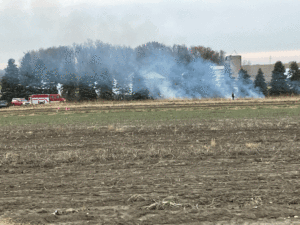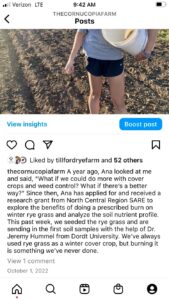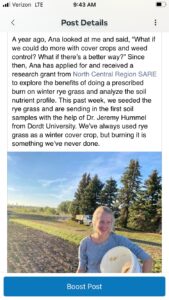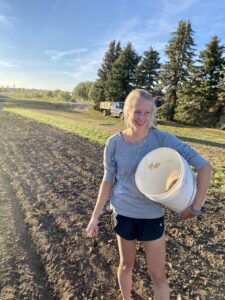Final report for FNC22-1357
Project Information
The Cornucopia is a small 8 acre vegetable farm founded by John and Janna Wesselius, both whom continue to grow the business. The farm also supports 4 full-time adults, two of which are John and Janna's daughter and son-in-law, and 4-6 college students during the summer. The farm owns about 2 acres of worked ground and rents 6 acres nearby. The farm grows about 40 different kinds of vegetables as well as multiple varieties of each of those vegetables. We have practiced crop rotation, cover cropping, and organic practices such as not using herbicides, pesticides, or fungicide since the business was founded in 2003. The Cornucopia has 2 heated greenhouses that we use for germinating and propagating transplants, and 4 unheated high tunnels that are in use year round. We anticipate completing two more of these high tunnels this spring. The farm was Certified Naturally Grown 6 years on and off. Due to the intensive upkeep of this certification, The Cornucopia is no longer Certified Naturally Grown, but continues to follow all of the sustainable practices outlined by the organization. The farm is a host for bee hives, and we have been intensively and actively creating more pollinator habitat on the farm in the last 5 years. We spread compost over all of the ground at least once a year, sometimes twice depending on the needs of the soil.
In order for plants to grow, they need the correct balance of seventeen essential macronutrients and micronutrients. Organic farmers are restricted by what they can and cannot add to the soil. These nutrients can be costly for small scale organic farmers. The Midwest used to be covered in native prairie which naturally burned every few years. Eventually the ash from the burned grass was turned back into the soil as compost. By burning cover crop, we may be able to mimic the natural process of prairie burning including adding nutrients back into the soil through increased decomposition of the cover crop. This process is not only cost effective for farmers since many already plant cover crops, but could also encourage long term soil health. Prairies also burn for weed control. This will be included in the second phase of our project. Some weed seeds when exposed to high heat are unable to germinate. If farmer’s don’t stay on top of weeds one year, then that same ground will be full of weeds the next year. Prescribed burning could help with controlling weedy patches of ground without the use of herbicides and help farmers cut down on labor costs.
1. Measure the benefits of prescribed burning through various soil tests analyzed by Midwest Laboratory.
2. Share findings by hosting university food science and agroecology labs.
3. Working with Dr. Jeremy Hummel of Dordt University on more opportunities for agriculture students to conduct senior research projects on this topic such as prescribed burning as a method of weed control.
4. Share findings by giving a presentation at the Practical Farmer’s of Iowa conference.
Cooperators
- (Educator)
Research
Twice in August of 2022, I pulled a disc behind the tractor to kill weeds and cultivate the soil. The Cornucopia did not plant any crops on the section we anticipated cover cropping during the 2022 growing season. We wanted the space to be available for whenever the conditions were right for broadcasting the rye grass. Before broadcasting rye grass, I took a soil sample and sent it to Midwest Laboratories, and I bought a Soil Health Complete Test. We received the results of this test in October, and analyzed them in January with a professor of agriculture from a local university. He explained what each part of the test meant, what the results of the test mean, and which numbers we should watch for change as we conduct this project.
On September 27, 2022, myself and John Wesselius, a project participant, broadcasted the winter rye grass. We used 3, 50 lbs. bags to cover .6 of an acre. The goal was to create a thick bed of rye grass to mirror the density of prairie grass. We intentionally seeded the rye grass right before a rain, and we saw germination on October 14, 2022. Even though we broadcasted the rye grass late in the season, we did see enough growth on the grass to prevent soil erosion this winter and into the spring.
A few times throughout the summer, we mowed the rye grass down a little above the growth point to keep it from reseeding itself next year. Then on November 10, 2023, our local fire department came out and did a prescribed burn on the rye grass. I took soil samples before burning and after burning, and ran the same tests on these soil samples as I did when I first took a soil sample. All tests were done through Midwest Laboratories. Once again, Dr. Hummel helped us evaluate the soil sample results and draw conclusions from the tests.
Attached is the first soil analysis that we ran before we broadcasted the rye grass.
We're using this soil test as a base line; we want to know what we're starting with so that we can accurately monitor change over the course of this research project. Dr. Jeremy Hummel, our university consultant, observed that the carbon to nitrogen ratio is 102:1 where the standard ratio is closer to 20:1. During our discussion about why the ratio is so high, Dr. Hummel asked what had previously been on the land we're using. In the fall of 2020, The Cornucopia planted garlic in this same space to be harvested in the summer of 2021. Garlic requires mulch over the winter to prevent it from dying and to help prevent early weeds in the spring. The Cornucopia uses wood animal bedding shavings for mulch which Dr. Hummel pointed out are high in carbon and low in nitrogen. This carbon to nitrogen ratio is one aspect of this project that we will continue to watch. When the rye grass is burned, some of the carbon will inevitably be released back into the air which will bring the ratio back into balance as well as increasing the availability of nutrients to plants. Another aspect of the soil test that our project is hoping to change is the organic matter percentage. Even though the soil has a 4% make-up of organic matter, we would like to see it closer to 8%. Building up organic matter in the soil takes patience, persistence, and time, but the goal of this project is to turn more green matter back into the soil and work towards raising that percentage.
This attached document contains the last two soil samples that I took in 2023.
One was while the rye grass was growing, and the other I took after we conducted a prescribed burn. There are notable differences between my initial soil sample before the rye grass and the soil sample after burning the rye grass. The most significant change is the nitrogen credit number from pre-rye to post burn. Nitrogen credits are based on the 1 Day CO2C Burst, which measures microbial activity and the ratio of organic carbon and nitrogen. Pre-rye the carbon to nitrogen ratio was 102.3:1. The recommended ratio is somewhere between 8:1 and 15:1. Post burn the nitrogen and carbon ratio is 21.7:1, a significant improvement. The nitrogen credits increased from 9 pre-rye to 22 post burn. Both the ratio and the nitrogen credits are indications of long term soil fertility. Even though the nitrate lbs/acre went down from 72 pre-rye to 31 lbs/acre post-burn, the nitrate acts more like fertilizer that can be washed away instead of the stable fertility that the carbon and nitrogen ratio offers. The Soil Health Calculation number is also significantly up from pre-rye to post-burn.
Dr. Jeremy Hummel from Dordt University helped me interpret the meaning of my soil tests. He noticed that while the post-burn numbers were significantly better than the pre-rye numbers, the 'with rye' soil sample numbers were even better. The 1 Day CO2C Burst was measured at 91 instead of 57 pre-rye and 54 post-burn. The organic carbon to nitrogen ratio was 17:1, closer to the optimal range than the post-burn ratio of 21.7:1. Dr. Hummel noted that there could be a wide variety of factors that cause the changes in numbers. However, his best assessment is that the cover crop did more for rebalancing the numbers and ratios than the burning did. The prescribed burn did not harm soil health, but it also did not dramatically improve soil health. He also commented that even though all three soil samples have slightly different rates of nutrient levels, those differences are not significant enough to take note of as being important. Soil is constantly changing, and there's a margin of changes allowed before the changes become notable. The final assessment of the soil sample results is that the project worked, just not necessarily to the extent that we were hoping for.
Soil sample results: This attached document is a chart comparing the results of the various soil samples, side by side.
Educational & Outreach Activities
Participation Summary:
John Wesselius and I had several consultations with Dr. Jeremy Hummel about interpreting our soil test results. Dr. Hummel explained the soil test results, and indicated which aspects of the test would change as we progress with this research project. With our final soil tests, he helped explain the results, what the meaning of them were, and whether or not the project worked.
In October of 2022, The Cornucopia hosted a field day for 3 labs from Dordt University. One was an agroecology class with Dr. Hummel with about 20 students participating. Dr. Hummel brings his agroecology class to The Cornucopia every year for a tour; and since he's consulting on the project, he was very excited for the opportunity for me to explain the project and its possible implications. John Wesselius, founder and owner of The Cornucopia, explained the practices of The Cornucopia and gave a short tour. I had the opportunity to explain this research project, its goals, and offer students the opportunity to continue research on the farm and for the proposed next phase of this project. Students were given the opportunity to ask questions about the project as well. For the other two field days, professor of agriculture Dr. John Olthoff from Dordt University brought both sections of his food science class to the farm. Dr. Olthoff also brings his food science labs to the farm for a tour every year. There were approximately 20 students in each section. Once again, after John Wesselius explained the practices of The Cornucopia, I was able to give a presentation on the research project. The food science labs are different from the agroecology lab. The students in the foods science labs are not majoring in agriculture, and they would not be able to help with future research. Since the students in the agroecology lab are able to help with future research, I was able to give a more in depth explanation of the project to them than I could give to the food science labs. The three Dordt University classes came out in the fall of 2022 and 2023. Dr. Olthoff and Dr. Hummel brought the students out to The Cornucopia both in 2022 and 2023, but each year was a different group of students.
Attached is the Instagram post, the Facebook post, and the post image that we used to promote the project on the farm. The picture was taken while broadcasting the rye grass. Both posts gained more attention on our social media page than a Cornucopia post has in a long time. The post on Instagram received 53 likes, 1 comment, and 315 people saw it. On Facebook, the post received 114 reactions, 8 comments, 1 share, 1,847 saw the post, and 271 people engaged with it without paying to boost either post. As we move into spring and now that the soil test results have been interpreted, we plan on creating another post highlighting what we have found thus far.
I also wrote about the progress of this project in the farm's weekly CSA letter.
Learning Outcomes
I learned several things from this project. The most significant one being that I now better understand how plants use the nutrients that are found in the soil as well as having a better understanding of how to read a basic soil test. We are planning for the 2024 season to greatly expand our use of cover crops at The Cornucopia now that I can understand the benefits and differences between different types of cover crops.
The greatest challenge we faced with the project was mowing the rye grass. We needed to mow it to prevent it from reseeding next year, but driving on the rye grass kills it. This gave weeds the opportunity to take over and potentially caused problems when we tried to burn the grass. We had the local fire department come out and conduct a prescribed burn for us on the rye grass on November 10, 2023. They had a very hard time getting the fire started. This could be caused by a number of different factors including soil moisture levels, the moisture levels of the grass/weeds, the temperature, and the humidity levels. The fire department was able to get several smaller fires started which has the same effect over all as a large fire, but we were not able to get the large fire we were hoping for started. One reason I did not apply for another grant next year is because The Cornucopia saw significant business growth during the 2022 and 2023 growing season. Managing this project took time away from focusing on the growing business. Not having a grant gives us the flexibility to forgo the project if we end up running out of time.
One part of the project that I would change would be the type of cover crop that I used. Instead of using winter rye grass, I would use Sorghum-Sudan grass. Sorghum-Sudan establishes faster and denser than winter-rye giving it better weed competition than rye, it does not reseed itself taking away the need for mowing the cover crop throughout the summer, and it creates a lot of biomass which better mimics the growth of prairie grass than what winter rye does. Without a grant, The Cornucopia is considering repeating this project using Sorghum-Sudan grass instead just to see what happens.
A recommendation I would make is that cover crops definitely work, which most farmers already know. The results of the burn were inconclusive and would need to be repeated to get a better idea of what's actually happening. However, burning does not harm soil health. The main goal of this project was to evaluate what doing a prescribed burn does and making sure that it did not harm soil health.
Project Outcomes
I would like to work with Dr. Hummel to create opportunities for Agriculture students at Dordt University to do on-farm research at The Cornucopia around this project. The timing of when grant proposals are due and Dr. Hummel's end of semester teaching schedule conflict with each other, making it difficult for us to get something written up on time. The Cornucopia will continue to seek out the best practices in farming and agroecology to create a more resilient and sustainable farming system with or without a grant.
Information Products
- Practical Farmer's of Iowa presentation (Conference/Presentation Material)
- Video: Prescribed Burning Cover Crops with Ana Timmer (Video)




